ROUBAIX, France (April 12, 2025) — The dust of northern France may never settle quite the same. On April 12th, 2025, in a solo surge of power and poetry, Pauline Ferrand-Prévot claimed a landmark victory at Paris-Roubaix Femmes avec Zwift, becoming the first French woman to conquer the storied cobblestones and cross the line alone inside the Roubaix velodrome. Cheered on by a thunderous crowd, she didn’t just win a race—she rewrote history on home soil.
In the dusty, deafening roar of the Velodrome André-Pétrieux, Ferrand-Prévot, wearing the colors of Team Visma | Lease a Bike, rode into the Roubaix velodrome solo, arms outstretched in triumph, the French tricolor fluttering in the crowd behind her.
This wasn’t just a win. It was a comeback, a statement, and a masterclass in determination and grit. Having returned to road racing in 2025 following her gold medal triumph in mountain biking at the Paris 2024 Olympic Games, Ferrand-Prévot proved she still had the fire, finesse, and fortitude that had made her a world champion in multiple disciplines.
The Hell of the North Beckons
The fifth edition of the Paris-Roubaix Femmes began under deceptively calm skies in Denain. 135 riders took to the start line after Sofie Van Rooijen (UAE Team ADQ) and Julie Hendrickx (Lotto Ladies) withdrew at the last minute. At precisely 1 p.m., the peloton rolled out for 148.5 km of punishing terrain, featuring 17 cobbled sectors identical to the 2024 route.
The race was aggressive from the outset. The first 20km were filled with attacks, attempts to forge a breakaway thwarted by the fierce pace. Finally, at km 33, Dutch rider Quinty Ton (Liv-AlUla-Jayco) and Poland’s Aurela Nerlo (Winspace Orange Seal) escaped, carving out a 2’20” advantage after 50km. Their lead ballooned to nearly three minutes as they approached the first cobbled sector from Hornaing to Wandignies (km 66), the race’s brutal heartbeat.
A Race That Never Rests
Cobbled chaos erupted in the Warlaing to Brillon sector, as Ellen van Dijk (Lidl-Trek) launched a characteristically bold attack. The Dutch powerhouse was soon flying solo, hunting down the leading duo with relentless resolve. By the fifth sector (Orchies), she had reached the front, with only Ton remaining. Nerlo had dropped off, and the peloton loomed just seconds behind.
Sector 12 saw a major crash—Lily Williams, Linda Riedmann, and others hit the deck, shaking up the chasing group. Lotte Kopecky (SD Worx-Protime) took the moment to launch an attack, dragging teammate Lorena Wiebes with her. Marianne Vos bridged across, and a new elite group formed.
This lead group swelled to eight as Chloe Dygert, Alison Jackson, Romy Kasper, and Jelena Eric joined the fray. But it didn’t hold. By the time they exited Mons-en-Pévèle (Sector 11), only six remained. Kopecky’s relentless tempo caused more attrition, with Kasper and even the instigator Van Dijk unable to stay with the group.
Behind them, the peloton was regrouping. With 35km to go and eight cobbled sectors remaining, the front of the race grew to 20 riders. It was here that Pauline Ferrand-Prévot appeared, silent and dangerous. Her presence was a quiet threat, and when she attacked, it came like a storm.
Ferrand-Prévot Strikes
Emma Norsgaard (Lidl-Trek) was the first to make a daring move, attacking after Templeuve (Sector 8) with 32km to go. She eked out a 36-second gap before Ferrand-Prévot made her move. The French rider attacked with 25km remaining, right as the race plunged into Sector 6 (Bourghelles to Wannehain).
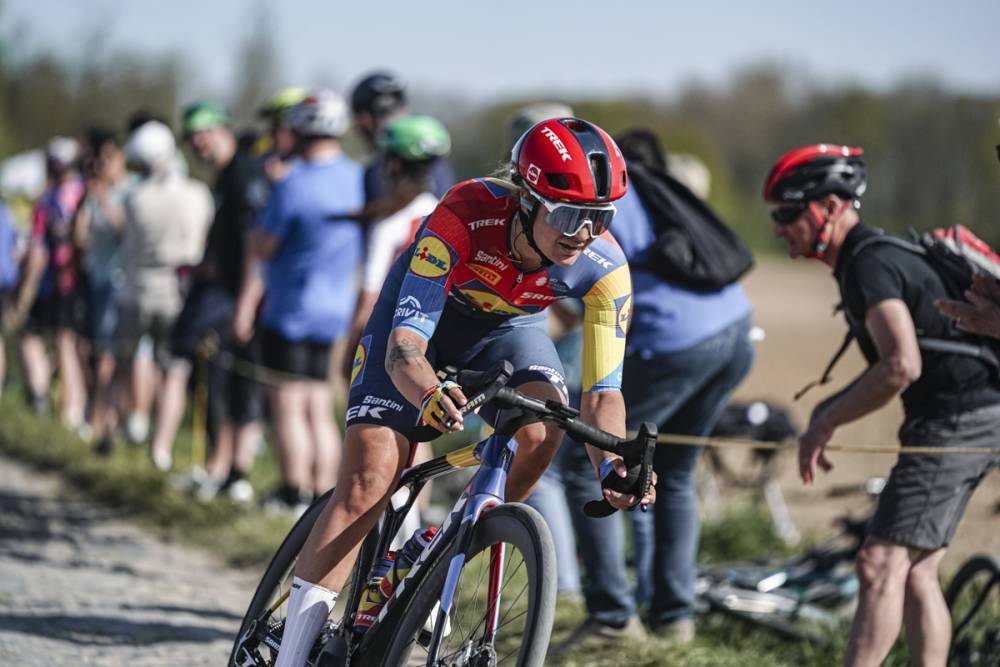 It was a classic Ferrand-Prévot attack—calculated, explosive, and perfectly timed. She quickly bridged to Norsgaard, then wasted no time pressing on alone. By Sector 5 (Camphin-en-Pévèle), she was off the front, a lone figure slicing through dust and cobbles.
It was a classic Ferrand-Prévot attack—calculated, explosive, and perfectly timed. She quickly bridged to Norsgaard, then wasted no time pressing on alone. By Sector 5 (Camphin-en-Pévèle), she was off the front, a lone figure slicing through dust and cobbles.
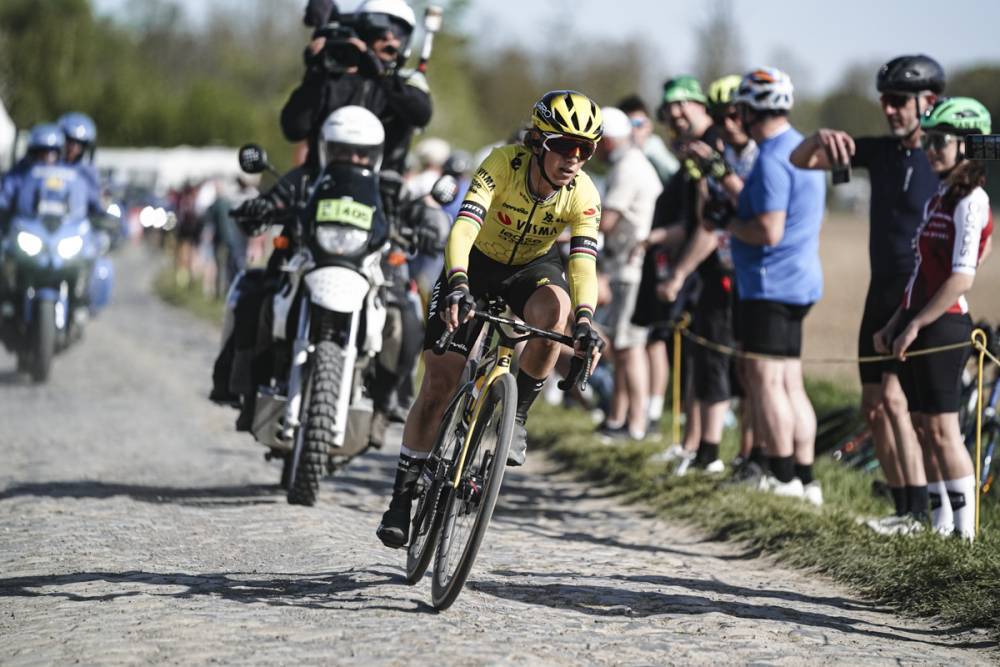
With 10km to go, she was 25 seconds ahead of Norsgaard and a full minute ahead of the chasing group. From that moment, her victory looked inevitable. The cobbles of Carrefour de l’Arbre and the winding streets into Roubaix only seemed to sharpen her determination.
Ferrand-Prévot never faltered. Her cadence remained strong, her focus unwavering. Her mountain biking background gave her a unique edge—balancing power and precision across the broken, uneven stones. With every cobbled kilometer behind her, the cheers from roadside fans grew louder. By the time she reached the final sector, she was met with a wall of sound.
Tactical Analysis: Timing, Terrain, and Tenacity
Ferrand-Prévot’s decisive attack didn’t just happen—it was built on a foundation of careful tactical thinking. Her positioning throughout the cobbled sectors was meticulous; never too exposed, yet always close enough to respond. Unlike some of her rivals who burned matches early, Ferrand-Prévot remained economical until the critical moment.
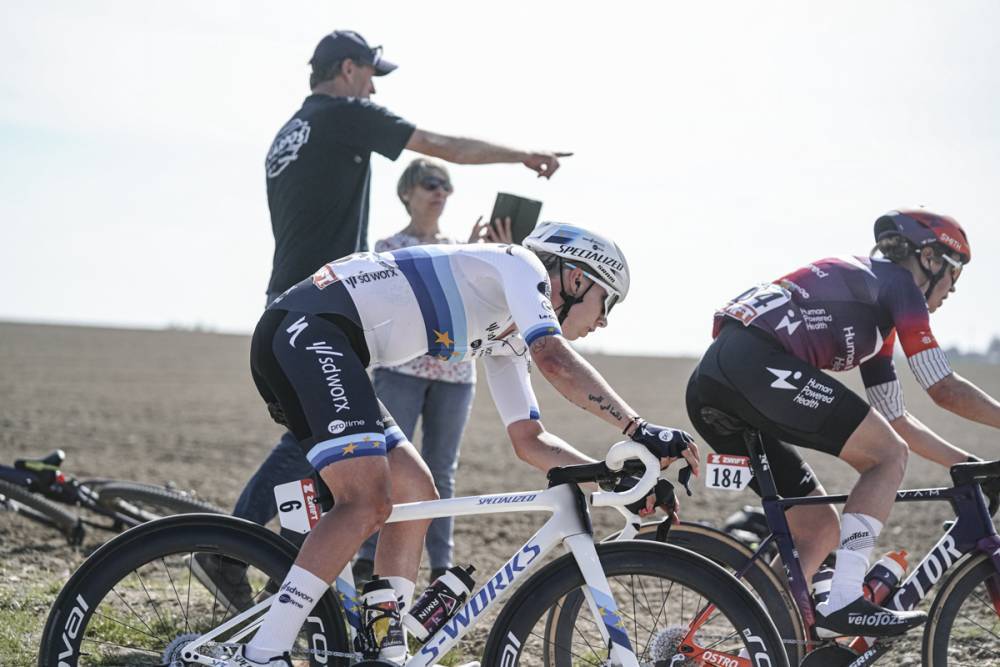
By launching her move just before Sector 6, she took advantage of a natural selection point on the course—riders were already fatigued from earlier attacks and crashes, and the cobbled terrain amplified any weakness. Her solo pursuit of Norsgaard was a statement of strength, but it also forced the chasers to gamble: who would sacrifice their legs to bring her back?
The dynamics of the chase were revealing. Once Ferrand-Prévot was clear, the cooperation behind her rapidly disintegrated. Teams like SD Worx-Protime and EF Education-Oatly each had multiple riders in the group but conflicting priorities. Kopecky was marked closely, reluctant to tow rivals; Wiebes was saving her sprint; Jackson and Borghesi hesitated to take long pulls without assurance. Lidl-Trek, having already launched Van Dijk and Norsgaard, had no remaining firepower to commit.
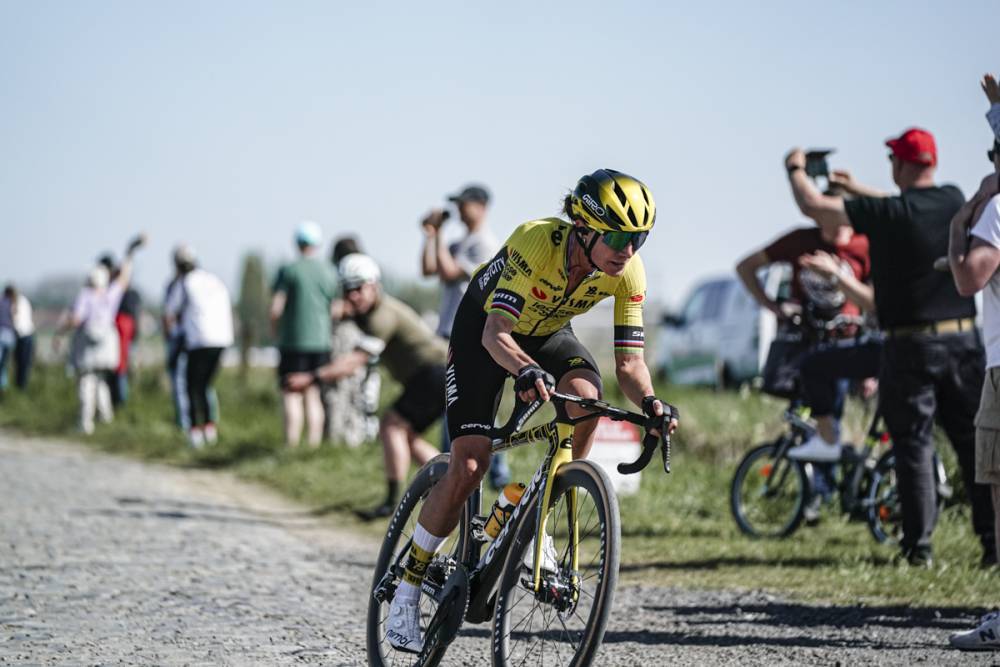
In the critical stretch from Camphin-en-Pévèle to Carrefour de l’Arbre, hesitation turned into fragmentation. Riders attempted solo bridges, but none had Ferrand-Prévot’s momentum or technical fluency. Kopecky made a half-hearted dig, quickly marked by Vos. The rest watched, waited, and second-guessed.
Ferrand-Prévot, meanwhile, was executing a negative split—a rare tactic in such a brutal race—riding faster in the final sectors than earlier in the day. That acceleration not only demoralized the chasers but made cooperation nearly irrelevant. It was a classic case of attack timing meeting indecision—a race won not only by strength, but by psychological edge.
A Nation’s Roar
The final cobbled sector, Roubaix (Espace Charles Crupelandt), offered no resistance. Ferrand-Prévot, grimacing but composed, flew through it, riding solo into the iconic velodrome. The crowd exploded. She allowed herself a smile, a wave, then raised both arms as she crossed the line. Behind her, Letizia Borghesi (EF Education-Oatly) arrived 58 seconds later to claim second. Wiebes outsprinted Vos and Jackson to round out the podium, 1’01” behind.
It was a triumphant moment not just for Ferrand-Prévot, but for a nation that had long yearned to see a homegrown talent triumph at this legendary race. Fans wept, cheered, and celebrated. In a sport of suffering, her joy was contagious.
Post-Race Emotions and Reflections
For Ferrand-Prévot, this win was personal, unexpected, and emotional.
“This was my first time at Paris-Roubaix Femmes, and maybe my last one! I had a crash before Mons-en-Pévèle and had to chase, but once I was back, I just went full gas. I’ve been sick the last two days so I wasn’t even sure this morning whether to participate at Paris-Roubaix. But I said OK we’ll just go and I’ll do my best for Marianne. Finally, I took the start and it’s amazing. My boyfriend [Dylan van Baarle] won three years ago and now I won. It’s quite incredible!”
“When I attacked, I was mostly thinking about helping Marianne, to make the others work behind. We really wanted to try to drop Lorena Wiebes (the best sprinter). They started looking at each other behind, and it worked to my advantage, so it was good.”
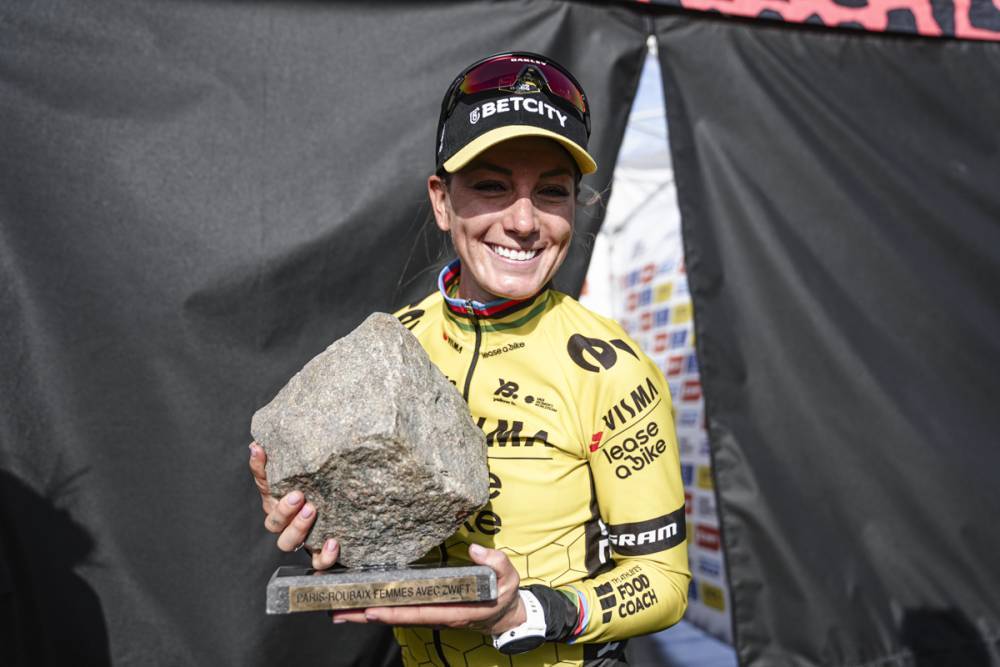 “I just attacked on a paved section. Marianne had told me to attack on a cobbled part, but I felt that we were already riding fast, and I wasn’t making any difference. I knew that after each cobbled section, everyone would need a little time to recover. And then I saw that it was now or never to go for it. Behind, it took some time for them to react. And after that, by the time they organized… Sometimes with the women, it’s a bit complicated, so you have to take advantage of it.”
“I just attacked on a paved section. Marianne had told me to attack on a cobbled part, but I felt that we were already riding fast, and I wasn’t making any difference. I knew that after each cobbled section, everyone would need a little time to recover. And then I saw that it was now or never to go for it. Behind, it took some time for them to react. And after that, by the time they organized… Sometimes with the women, it’s a bit complicated, so you have to take advantage of it.”
Her words reflected the unpredictable nature of racing, and the underlying resilience of a rider who has fought through injuries, illnesses, and the weight of expectation to reach the top once again.
Letizia Borghesi reflected on a gritty and determined performance at the race, marked by early adversity and a strong comeback.
“I had a flat tyre so I had to chase… I think I came back after four sectors or something like that,” she explained. Rejoining the front group wasn’t easy, with the pace high and rivals unwilling to let anything slip. Once back, Borghesi launched several attacks of her own, describing the group as “racing really aggressively” while SD Worx tried to control the action. Though she couldn’t follow Pauline Ferrand-Prevot’s decisive move, Borghesi expressed pride in both her own performance and that of her EF Education-Oatly team.
Looking back on her season so far, Borghesi noted major progress and growing confidence. “These are my favourite races… and this year I reached a level that I didn’t have in the past,” she said. From strong rides at Strade Bianche and Milano-Sanremo to solid performances at Flanders and Roubaix, she sees this spring as a breakthrough.
“I improved year after year, without forcing, leaving myself time for my body to grow,” she added, proud of her steady development. With a solid foundation, she believes her team is now a real contender among the sport’s elite. “We know that we can really fight with the biggest teams,” she said. “It’s crazy the level that we reached this year.”
Lorena Wiebes, despite missing the win, was philosophical, as she reflected on a tough race with a mix of disappointment and pride, acknowledging the challenges she and her SD Worx-Protime teammate Lotte Kopecky faced.
“At the end of the race, out of nowhere, I cramped a bit in my legs when they attacked in the last four kilometres,” she said, explaining how the final moments played out. With only two teammates in the front group, reacting to every attack was nearly impossible.
“Sometimes you have to gamble,” she admitted, especially when racing against strong riders like Pauline Ferrand-Prevot and Ellen van Dijk. Wiebes clarified there was no miscommunication within her team, saying, “I didn’t say to Lotte at all to not attack. I only said to her, not to attack when I’m leading at the front. So that’s a big difference.”
Despite not taking the win, Wiebes expressed pride in the team’s effort and consistency throughout the spring campaign. “We were fighting for it all the time… It’s easy when you win all the races, but you cannot always win,” she said, showing both realism and resilience. While the immediate result brought “mixed feelings,” she acknowledged the bigger picture: “I think I can be really happy with what we achieved, and it’s still not over yet because the Ardennes classics are coming up.” Though the night might bring less sleep than a victory would, she believes pride will follow soon enough.
A Monumental Moment for Women’s Cycling
Ferrand-Prévot’s victory is a watershed moment for women’s cycling in France. Paris-Roubaix, once considered too brutal for women, now sees French women conquering its most legendary stretches. From the mud of Hornaing to the polished concrete of Roubaix, her triumph will resonate for years.
This edition of Paris-Roubaix Femmes showcased the grit, strategy, and drama that makes this race one of the most revered on the calendar. From early breakaways and mechanicals to crashes, bold solo efforts, and the final glory lap in the velodrome, it had everything.
It also underlined the evolution of the women’s peloton. No longer merely mirroring the men’s races, events like Paris-Roubaix Femmes have taken on a life of their own. They are marked by high-level tactics, compelling rivalries, and ever-deepening rosters of talent.
Ferrand-Prévot’s win was a symbol of persistence and adaptability. A rider who has conquered cross-country mountain biking, cyclocross, and road racing, she stands as a beacon for versatility and resilience in modern cycling. Her win was not just for France—it was for the sport itself.
Legacy and the Road Ahead
The legacy of this win goes far beyond Roubaix. It underscores the impact of investing in women’s cycling, building deeper teams, offering more race days, and giving riders the platform to shine. In Ferrand-Prévot, we see the reward of decades of dedication—not just hers, but the efforts of an entire sport pushing toward parity.
Young riders, especially in France, now have a new role model—one who blends talent with tenacity. Her win may inspire the next generation to dream of Roubaix not just as a legend, but as an attainable goal.
With the Ardennes Classics on the horizon and the Tour de France Femmes later in the year, Ferrand-Prévot’s performance is likely to galvanize her team and inspire a new generation of French cyclists. The peloton has taken note. The Queen of Roubaix wears tricolor.
Results Summary:
|
RANK
|
RIDER | RIDER NO. | TEAM | TIMES | GAP |
| 1 | PAULINE FERRAND PREVOT | 32 | TEAM VISMA | LEASE A BIKE | 03H 40′ 07” | – |
| 2 | LETIZIA BORGHESI | 83 | EF EDUCATION – OATLY | 03H 41′ 05” | + 00H 00′ 58” |
| 3 | LORENA WIEBES | 6 | TEAM SD WORX – PROTIME | 03H 41′ 08” | + 00H 01′ 01” |
| 4 | MARIANNE VOS | 31 | TEAM VISMA | LEASE A BIKE | 03H 41′ 08” | + 00H 01′ 01” |
| 5 | ALISON JACKSON | 81 | EF EDUCATION – OATLY | 03H 41′ 08” | + 00H 01′ 01” |
| 6 | MARIA GIULIA CONFALONIERI | 134 | UNO-X MOBILITY | 03H 41′ 08” | + 00H 01′ 01” |
| 7 | ELISE CHABBEY | 41 | FDJ-SUEZ | 03H 41′ 11” | + 00H 01′ 04” |
| 8 | CHLOE DYGERT | 73 | CANYON//SRAM ZONDACRYPTO | 03H 41′ 13” | + 00H 01′ 06” |
| 9 | ELISA BALSAMO | 11 | LIDL – TREK | 03H 41′ 28” | + 00H 01′ 21” |
| 10 | CHIARA CONSONNI | 72 | CANYON//SRAM ZONDACRYPTO | 03H 41′ 28” | + 00H 01′ 21” |







